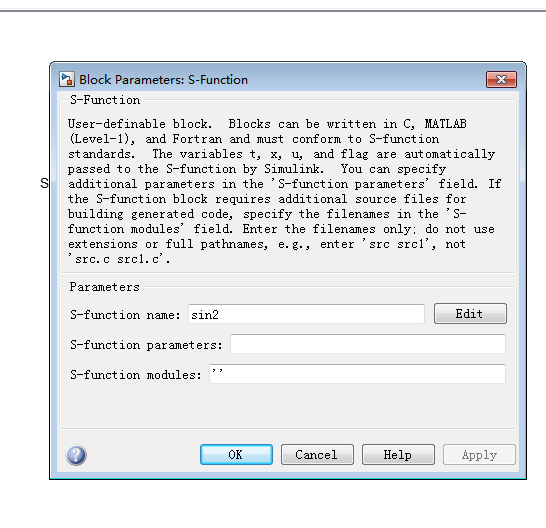matlab/simulink中自定义c-s函数作为simulink模块使用实例
一般而言matlab/simulink能满足多数使用要求,但是往往在研究中会使用User-difinition s-function或者调用c,c++的库函数,这时候就需要matlab能进行c,c++以及fortran语言的编译。
本文是我第一次参考资料,利用c语言编写s函数的实例。User-Definition的s-fun可以作为一个simulink模块使用,这样在工程和科研中就可以自己开发需要的模块,并入simulink仿真之中,不必受制于simulink自带的有限模块。使用c语言写s-fun需要mingw编译器。
与m-sfun不同的是用c语言编写的sfun需要先经过mingw编译,生成mexw可执行文件(有资料也说是dll文件),然后才可以在自定义的s-fun模型中使用。
题目:编写User-Definition的s-fun,使得正弦函数的波形加倍2倍,然后输出到scope。
实现步骤:
1. 新建simulink模型,拖入User-Definition的s-fun,然后双击s-fun,点击edit,进入编辑模块;
![]()
2. 编写m-sfun代码,并另存为sin2.m,可以参照c-sfun的格式,具体代码如下:
/*
* sfuntmpl_basic.c: Basic 'C' template for a level 2 S-function.
*
* Copyright 1990-2013 The MathWorks, Inc.
*/
/*
* You must specify the S_FUNCTION_NAME as the name of your S-function
* (i.e. replace sfuntmpl_basic with the name of your S-function).
*/
#define S_FUNCTION_NAME sin2 //这里的sin2一定要与c文件的文件名一致
#define S_FUNCTION_LEVEL 2
/*Level 2 M文件S函数----支持访问更多地S函数API,支持代码生成。当你要使用M文件
* 来实现一个S函数的时候,选择Level 2 M文件S函数。
*/
/*
* Need to include simstruc.h for the definition of the SimStruct and
* its associated macro definitions.
*/
#include "simstruc.h"
//程序里用到的头文件在这里引用
/*====================*
* S-function methods *
*====================*/
/* Function: mdlInitializeSizes ===============================================
* Abstract:
* The sizes information is used by Simulink to determine the S-function
* block's characteristics (number of inputs, outputs, states, etc.).
*/
static void mdlInitializeSizes(SimStruct *S)
{
//这个函数用来设置输入、输出和参数
ssSetNumSFcnParams(S, 0); /* Number of expected parameters */
//设置参数个数,这里为0
if (ssGetNumSFcnParams(S) != ssGetSFcnParamsCount(S)) {
/* Return if number of expected != number of actual parameters */
return;
}
// ssSetNumContStates(S, 0); //设置连续状态的个数,缺省为0
// ssSetNumDiscStates(S, 0); //设置离散状态的个数,缺省为0
if (!ssSetNumInputPorts(S, 1)) return; //设置输入变量的个数,这里为1
ssSetInputPortWidth(S, 0, DYNAMICALLY_SIZED); //设置输入变量0的维数为动态的
// ssSetInputPortRequiredContiguous(S, 0, 1); /*direct input signal access*/
/*
* Set direct feedthrough flag (1=yes, 0=no).
* A port has direct feedthrough if the input is used in either
* the mdlOutputs or mdlGetTimeOfNextVarHit functions.
*/
/*
*设置input0的访问方式,true就是临近访问,这样指针的增量后
* 就可以直接访问下个input端口
*/
ssSetInputPortDirectFeedThrough(S, 0, 1);
//设置输入端口的信号是否在mdlOutputs函数中使用,这里设置为true
if (!ssSetNumOutputPorts(S, 1)) return;
//设置输出变量的个数,这里为1
ssSetOutputPortWidth(S, 0, DYNAMICALLY_SIZED); //设置输出变量0的维数为动态
// ssSetOutputPortWidth(S, 1, 1); //设置输出变量1的维数为1
ssSetNumSampleTimes(S, 1); //设置采样时间1s
//ssSetNumRWork(S, 0);
// ssSetNumIWork(S, 0);
//ssSetNumPWork(S, 0);
//ssSetNumModes(S, 0);
// ssSetNumNonsampledZCs(S, 0);
/* Specify the sim state compliance to be same as a built-in block */
// ssSetSimStateCompliance(S, USE_DEFAULT_SIM_STATE);
ssSetOptions(S, SS_OPTION_EXCEPTION_FREE_CODE);
}
/* Function: mdlInitializeSampleTimes =========================================
* Abstract:
* This function is used to specify the sample time(s) for your
* S-function. You must register the same number of sample times as
* specified in ssSetNumSampleTimes.
*/
static void mdlInitializeSampleTimes(SimStruct *S)
{
ssSetSampleTime(S, 0, INHERITED_SAMPLE_TIME);
ssSetOffsetTime(S, 0, 0.0);
}
//#define MDL_INITIALIZE_CONDITIONS /* Change to #undef to remove function */
//#if defined(MDL_INITIALIZE_CONDITIONS)
/* Function: mdlInitializeConditions ========================================
* Abstract:
* In this function, you should initialize the continuous and discrete
* states for your S-function block. The initial states are placed
* in the state vector, ssGetContStates(S) or ssGetRealDiscStates(S).
* You can also perform any other initialization activities that your
* S-function may require. Note, this routine will be called at the
* start of simulation and if it is present in an enabled subsystem
* configured to reset states, it will be call when the enabled subsystem
* restarts execution to reset the states.
*/
static void mdlOutputs(SimStruct *S, int_T tid)
{
int_T i;
InputRealPtrsType uPtrs = ssGetInputPortRealSignalPtrs ( S,0 );
real_T *y = ssGetOutputPortRealSignal (S,0 );
int_T width = ssGetOutputPortWidth ( S,0 );
for ( i=0;i3. sin2.c完成之后,需要生成sin2.mexw,在命令行键入 mex sin2.c即可
>> mex sin2.c
使用 'MinGW64 Compiler (C)' 编译。
MEX 已成功完成。4. 将matlab工作目录更改为sin2.mexw所在的文件夹,然后双击simulink模块,将sin2填入s-function name,由于本例不需要输入参数,故其他不需要填写。
5. 运行。

